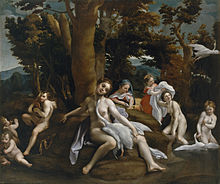Leda and the Swan (Correggio)
| Leda and the Swan | |
|---|---|
 | |
| Artist | Antonio da Correggio |
| Year | c. 1532 (Julian) |
| Medium | oil on canvas |
| Dimensions | 152 cm (60 in) × 191 cm (75 in) |
| Commissioned by | Federico II Gonzaga, Duke of Mantua |
| Collection | Gemäldegalerie |
| Accession No. | 218 |

Leda and the Swan (known in Italian as Leda) is an oil on canvas painting from 1530–31 by the Italian painter
History
Correggio conceived a series of works entitled Amori di Giove or Love Affairs of Jupiter after the success of Venus and Cupid with a Satyr. The series eventually consisted of two pairs of works, each pair having the same dimensions, though he may have planned for there to be more. The precise order of the four works is still debated, though their main importance lies in their contribution to the development of secular and mythological painting via its new and extraordinary balance between naturalist rendering and poetic transfiguration.[2] Correggio had made a study of Michelangelo's Leda and the Swan.[3]
According to
In 1601
What was left of the painting was given to Charles-Antoine Coypel, first painter to the king, who painted a replacement head. Still in pieces, the painting was sold in 1753 to the collector Pasquier, who commissioned the painter Jacques-François Delyen to paint a new replacement head – in 1755 the count of Epinaille bought it on behalf of Frederick the Great, who hung it in his summer palace of Sanssouci. It was confiscated by Napoleon and restored again by Pierre-Paul Prud'hon before being returned to Germany in 1814 and placed in the Berlin museums in 1830 – there Jakob Schlesinger painted a third replacement for Leda's head.[6] However, the 1604 copy shows that even this restoration censored Correggio's original composition, giving Leda a chaste rather than orgasmic expression and removing the backwards twist of her head that Correggio had originally intended (similar to that of Io in his Jupiter and Io).
See also
References
- ^ a b "Leda mit dem Schwan". Staatliche Museen zu Berlin (Berlin State Museums). Retrieved 2024-04-22.
- ISBN 88-451-7212-0
- Arthur Ewart Popham, Correggio's Drawings, London 1957, cat. n. 84.
- Le vite de' più eccellenti pittori, scultori e architettori, Firenze 1550, ed. cons. a cura di Luciano Bellosi e Aldo Rossi, Einaudi, Torino1991, II, p. 563.
- ^ Egon Verheyen, Correggio's Amori di Giove, in Journal of the Warburg and Courtauld Institutes, XXIX (1966), pp. 160–192.
- ^ Cecil Gould, The paintings of Correggio, London 1976, pp. 194–196.
Bibliography
- (in Italian) Giuseppe Adani, Correggio pittore universale, Silvana Editoriale, Correggio 2007. ISBN 978-88-366-0977-2
External links
- "Scheda in Correggio Art Home, da cui proviene una parte del testo" (in Italian). Archived from the original on 2016-03-04. Retrieved 2017-08-04.
